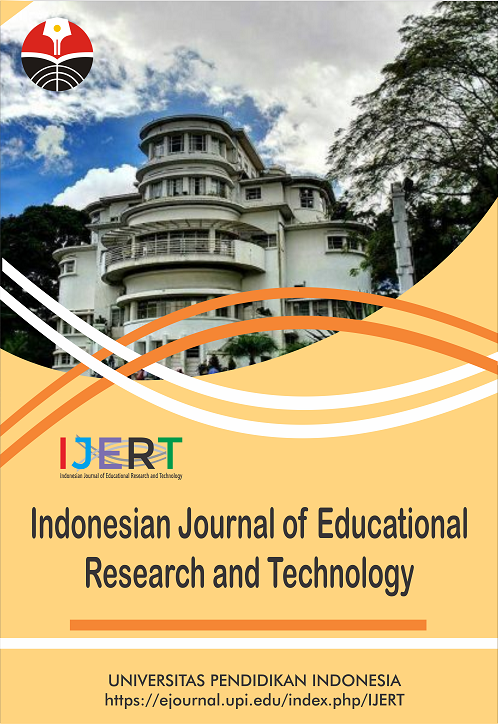Availability and Utilisation of information and communications technology for Effective Learning Habits among Secondary School Students
Abstract
Keywords
Full Text:
PDFReferences
Abubakar, B. G., and Bello, M. B. (2020). Access and utilization of internet for teaching and learning among secondary schools in Bauchi state Nigeria: A study of six (6) selected secondary schools. Journal of Humanities and Social Science 20(6), 218-238.
Aderanti, R. A., and Adedotun, A. (2015). Perceived influence of information sources availability and use on the academic performance of secondary school students in a Nigerian metropolitan city. American Journal of Educational Research 3(11), 1346 -1349.
Akinoso, S. O. (2023). Motivation and ICT in secondary school mathematics using unified theory of acceptance and use of technology model. Indonesian Journal of Educational Research and Technology, 3(1), 79-90.
Amiaya, A. O. (2014). Integrating new technologies into office technology and management curriculum challenges and strategies. Business Education Journal, 1(2), 101-113.
Arciosa, R. M. (2022). Information communication technology (ICT)-based instructional software and its effectiveness in teaching high school geometry. Indonesian Journal of Teaching in Science, 2(1), 51-60.
Bingimlas, K. A. (2009). Barriers to the successful integration of ICT in teaching and learning environment: A review of the literature. Eurasia Journal of Mathematics, Science and Technology Education, 5(3), 235-245.
Bolaji, H. O. and Adeoye, M. A. (2022). Accessibility, usability, and readiness towards ICT tools for monitoring educational practice in secondary schools. Indonesian Journal of Multidiciplinary Research, 2(2), 257-264.
Bolaji, H. O., and Jimoh, H. A. (2023). Usability and utilization of ICT among educational administrators in secondary students in public school. Indonesian Journal of Educational Research and Technology, 3(2), 97-104.
Daramola, F. O. (2023). Utilization of ICT resources for teaching among some selected lecturers in colleges of education in Kwara State. ASEAN Journal of Educational Research and Technology, 2(1), 1-10.
Dwiana, O., Muktiarni, M., and Mupita, J. (2022). Improved information literacy of elementary school students about living pharmacies through information and communication media (ICT). ASEAN Journal of Science and Engineering Education, 2(3), 193-198.
Jadhav, P., Gaikwad, H., and Patil, K. S. (2022). Teaching and learning with technology: Effectiveness of ICT integration in schools. ASEAN Journal of Science Education, 1(1), 33-40.
Kumar, R., and Kaur, A. (2005). Internet and its use in the engineering college of Punjab, India: A case study. Webology, 2(2005), 1-18.
Makoye, J. N. (2003). Strategic issues in ICTE implementation in schools and teacher colleges: The Tanzanian context. The Tanzania Education Journal, 23(22), 22-33.
Nwana, S. E., Ofoegbu, T. O., and Egbe, C. I. (2017). Availability and utilization of ICT resources in teaching computer education in secondary schools in Anambra state, Nigeria. Mediterranean Journal of Social Sciences, 8(5), 111-111.
Olatokun, W. M. (2008). Internet access and usage by secondary school students in a Nigerian municipality. South African Journal of Libraries and Information Science, 74(2), 138-148.
Ololube, N. P. (2006). Appraising the relationship between ICT usage and integration and the standard of teacher education programs in a developing economy. International Journal of Education and Development using ICT (IJEDICT), 2(3), 70-85.
Sahin, Y. G., Balta, S., and Ercan, T. (2010). The use of internet resources by university students during their course projects elicitation: A case study. TOJET: The Turkish Online Journal of Educational Technology, 9(2), 234-244.
Shah, S. S. (2022). Teaching and learning with technology: Effectiveness of ICT integration in schools. Indonesian Journal of Educational Research and Technology, 2(2), 133-140.
Wittwer, J., and Senkbeil, M. (2008). Is students’ computer use at home related to their mathematical performance at school?. Computers and Education, 50(4), 1558-1571.
DOI: https://doi.org/10.17509/ijert.v2i3.51064
Refbacks
- There are currently no refbacks.
Copyright (c) 2022 Universitas Pendidikan Indonesia (UPI)

This work is licensed under a Creative Commons Attribution-ShareAlike 4.0 International License.







.png)




